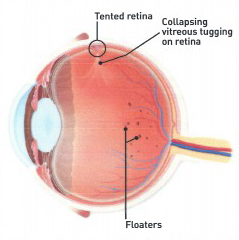
Although the floaters appear to be in front of the eye,
they are actually floating in the vitreous fluid inside the eye
.At times, you may notice small specs or clouds moving in your field of vision. These are called floaters. You can usually see them while looking at a plain background such as a blank wall. Floaters are tiny clumps of gel or cells inside the vitreous, the clear gel like fluid, which fills the inside of your eye. Though these objects appear to be in front of your eye. They are actually floating inside of it. What you see are the shadows they cast on the retina, the layer of cells lining the back of the eye that senses light and allows you to see. Floaters can appear as different shapes such as small dots, circles, lines, clouds or cobwebs.
CAUSES OF FLOATERS
As people reach middle age, the vitreous gel may begin to thicken or shrink, forming clumps or strands inside the eye. The vitreous gel pulls away from the back wall of the eye causing a posterior vitreous detachment, which is a common cause of floaters.
Posterior vitreous detachment is more common for people who:
- Are nearsighted
- Have undergone cataract surgery
- Have had a YAG laser surgery
- Have has inflammation inside the eye
You should contact your ophthalmologist right away if you develop new floaters, especially is you are over 45 years of age.
ARE FLOATERS EVER SERIOUS?
If the shrinking vitreous gel pulls away from the wall of the eye, the retina can tear. This can cause a small amount of bleeding in the eye, which may appear as new floaters. A torn retina can lead to retinal detachment. See your ophthalmologist if a new floater appears suddenly, if you see sudden flashes of light, or if you experience loss of side vision.
CAN FLOATERS BE REMOVED?
Floaters may be a symptom of a tear in the retina, which is a serious concern. If the tear is not treated, the retina may detach. The only treatment for a detached retina is surgery. Other floaters are harmless and fade over time or may become less bothersome, requiring no treatment. Surgery to remove floaters is almost never required. Even if you have had floaters for years, you should schedule an eye exam if you suddenly notice new ones.
CAUSES OF FLASING LIGHTS
When the vitreous gel rubs or pulls on the retina, you may see what looks like flashing lights or lightning streaks. You may have experienced this if you have been hit in the eye and seen “stars.” The flashes of light can appear on and off for several weeks or months. The older we are, it is more common to experience these flashes. If you notice the sudden appearance of light flashes, you should contact your ophthalmologist in case the retina has been torn.
MIGRAINE
Some people may experience flashes of light that appear as jagged lines in both eyes, often lasting 10 to 20 minutes. These types of flashes are usually caused by a spasm of blood vessels in the brain, which is called a migraine. If a headache follows the flashes, it is called a migraine headache. However, jagged lines can appear without a headache. In this case, the light flashes are called an ophthalmic migraine. Contact your ophthalmologist if you experience these symptoms.
Lauderdale Eye Specialists provides this on-line information for educational purposes only and it should not be construed as personal medical advice. Lauderdale Eye Specialists disclaims any & all liability for injury or other damages that could result from use of the information obtained from this site.


